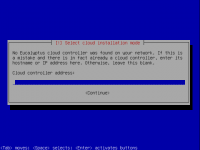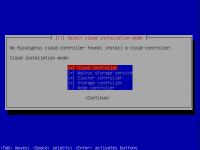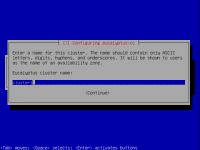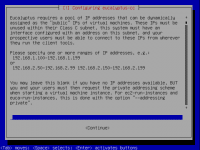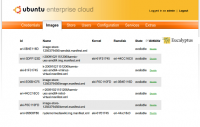Difference between revisions of "Ubuntu Enterprise Cloud: Instalasi UEC"
Onnowpurbo (talk | contribs) |
Onnowpurbo (talk | contribs) |
||
| Line 308: | Line 308: | ||
Keterangan berikut ini adalah cara yang paling sederhana untuk menginstalasi image. | Keterangan berikut ini adalah cara yang paling sederhana untuk menginstalasi image. | ||
| − | ''' | + | |
| − | BAGI ANDA YANG MEMPUNYAI KECEPATAN TINGGI DI INTERNET.''' Cara yang paling sederhana untuk menambahkan image UEC adalah menginstalasi dari Image Store melalui interface UEC web. | + | '''BAGI ANDA YANG MEMPUNYAI KECEPATAN TINGGI DI INTERNET.''' Cara yang paling sederhana untuk menambahkan image UEC adalah menginstalasi dari Image Store melalui interface UEC web. |
* Akses interface Web melalui URL berikut (Pastikan anda menggunakan https): | * Akses interface Web melalui URL berikut (Pastikan anda menggunakan https): | ||
Revision as of 11:23, 20 October 2010
Objectif
Dalam tutorial ini kita akan belajar bagaimana cara menginstalasi, mengkonfigur, mendaftarkan dan melakukan beberapa operasi pada setup UEC dasar yang mudah-mudahan akan menghasilkan sebuah controller "front-end" dan satu atau lebih node yang menjalankan Virtual Machine (VM) instances. kita akan menggunakan beberapa contoh untuk membantu kita dapat membuat sendiri private compute cloud.
Download
- Download iso Ubuntu Server dari
http://www.ubuntu.com/server/get-ubuntu/download
STEP 1: Persyaratan
Untuk menjalankan sebuah infrastruktur cloud minimal, kita akan membutuhkan paling tidak dua (2) sistem dedicated.
- sebuah front end.
- sebuah atau lebih node.
Berikut ini adalah rekomendasi spec.
Front End
Gunakan tabel berikut untuk sebuah sistem yang akan menjalankan satu atau lebih:
- cloud controller (clc)
- cluster controller (cc)
- walrus (S3-like storage service)
- storage controller (sc)
| Hardware | Minimum | Suggested | Notes |
|---|---|---|---|
| CPU | 1GHz | 2 x 2GHz | for an all-in-one front end, it helps to have at least a dual core processor |
| Memory | 2GB | 4GB | the Java web front end benefits from lots of available memory |
| Disk | 5400rpm IDE | 7200rpm SATA | slower disks will work, but will yield much longer instance startup times |
| Disk Space | 40GB | 200GB | 40GB is only enough space for only a single image, cache, etc., Eucalyptus does not like to run out of disk space |
| Networking | 100Mbps | 1000Mbps | machine images are hundreds of MB, and need to be copied over the network to nodes |
Node(s)
Untuk sistem yang berupa node, yang akan menjalankan:
- node controller (nc)
Sistem ini yang akan menjalankan instances. Anda akan membutuhkan satu atau lebih sistem dengan
| Hardware | Minimum | Suggested | Notes |
|---|---|---|---|
| CPU | VT extensions | VT, 64-bit, Multicore | 64-bit can run both i386, and amd64 instances; by default, Eucalyptus will only run 1 VM per CPU core on a Node |
| Memory | 1GB | 4GB | additional memory means more, and larger guests |
| Disk | 5400rpm IDE | 7200rpm SATA or SCSI | Eucalyptus nodes are disk-intensive; I/O wait will likely be the performance bottleneck |
| Disk Space | 40GB | 100GB | images will be cached locally, Eucalyptus does not like to run out of disk space |
| Networking | 100Mbps | 1000Mbps | machine images are hundreds of MB, and need to be copied over the network to nodes |
STEP 2: Install Cloud/Cluster/Storage/Walrus Front End Server
- Download 10.04 atau 10.10 Server ISO
- Ubuntu 10.04 - Pada saat booting, pilih “Install Ubuntu Enterprise Cloud”.
- Ubuntu 10.10 - Pada saat booting, ketik cloud.
- Installer akan mendeteksi jika ada komponen Eucalyptus lain di jaringan.
- Kita dapat memilih komponen mana yang akan di install, tergantung topologi yang kita pilih.
- Installer akan menanyakan dua (2) pertanyaan yang spesifik untuk cloud pada saat instalasi, yaitu:
- Nama dari cluster kita, misalnya, cluster1.
- Range dari IP address LAN yang akan di alokasikan oleh cloud ada instances, misalnya, 192.168.1.200-192.168.1.249.
STEP 3: Install Node Controller
Instalasi node controller lebih sederhana. Pastikan bahwa kita tersambung ke jaringan dimana cloud/cluster controller sudah running.
- Boot menggunakan ISO yang sama untuk node.
- Pilih “Install Ubuntu Enterprise Cloud”
- Installer harusnya mendeteksi Cluster dan preselect “Node” install untuk kita
- Konfirmasikan partisi harddisk
- Proses instalasi selanjutnya harus dilakukan tanpa berhenti; selesai sudah proses instalasi dan reboot node.
STEP 4: Proses Registrasi Node
Semenjak Ubuntu 10.04 LTS, semua registrasi komponen harusnya berlangsung secara automatis, dengan asumsi:
- Public SSH key dapat di pertukarkan dengan benar.
- Layanan / service dapat di konfigasi dengan benar.
- Layanan / service mempublikasikan keberadaannya di jaringan
- uec-component-listener yang benar berjalan
- Melakukan verifikasi registrasi.
Langkah ini hanya di perlukan kalau kita menggunakan langkah / metoda UEC/PackageInstall. Jika kita menggunakan langkah Ubuntu Enterprise Cloud: Instalasi UEC semua langkah ini biasanya sudah dilakukan secara automatis, kita tidak perlu melakukan langkah ini lagi.
Pertukaran Public SSH Key
Eucalyptus user Cloud Controller membutuhkan akses SSH ke Walrus Controller, Cluster Controller, dan Storage Controller sebagai eucalyptus user.
Install Cloud Controller eucalyptus user public ssh key dengan cara:
- Di target controller, set password sementara untuk eucalyptus user:
sudo passwd eucalyptus
- Kemudian pada Cloud Controller:
sudo -u eucalyptus ssh-copy-id -i /var/lib/eucalyptus/.ssh/id_rsa.pub eucalyptus@<IP_OF_NODE>
- Selanjutnya kita dapat membuang password eucalyptus account di target controller, jika kita inginkan:
sudo passwd -d eucalyptus
Konfigurasi Layanan / Service
Pada Cloud Controller:
- Untuk Registrasi Cluster Controller:
- Definisikan shell variable CC_NAME di /etc/eucalyptus/eucalyptus-cc.conf
- Definisikan shell variable CC_IP_ADDR di /etc/eucalyptus/eucalyptus-ipaddr.conf, sebagai daftar IP address yang di pisahkan spasi.
- Untuk Registrasi Walrus Controller:
- Definisikan shell variable WALRUS_IP_ADDR di /etc/eucalyptus/eucalyptus-ipaddr.conf, sebagai sebuah IP address
Pada Cluster Controller:
- Untuk Registrasi Storage Controller:
- Definisikan nama cluster di shell variable CC_NAME di /etc/eucalyptus/eucalyptus-cc.conf
- Definisikan shell variable SC_IP_ADDR di /etc/eucalyptus/eucalyptus-ipaddr.conf, berupa IP address yang dipisahkan oleh spasi.
Publikasi
Sekarang, kita dapat mulai mempublikasi layanan ke jaringan
- Walrus Controller:
sudo start eucalyptus-walrus-publication
- Cluster Controller:
sudo start eucalyptus-cc-publication
- Storage Controller:
sudo start eucalyptus-sc-publication
- Node Controller
sudo start eucalyptus-nc-publication
Start Listener
Pada Cloud Controller dan Cluster Controller, jalankan:
sudo start uec-component-listener
Verifikasi Registrasi
cat /var/log/eucalyptus/registration.log 2010-04-08 15:46:36-05:00 | 24243 -> Calling node cluster1 node 10.1.1.75 2010-04-08 15:46:36-05:00 | 24243 -> euca_conf --register-nodes returned 0 2010-04-08 15:48:47-05:00 | 25858 -> Calling walrus Walrus 10.1.1.71 2010-04-08 15:48:51-05:00 | 25858 -> euca_conf --register-walrus returned 0 2010-04-08 15:49:04-05:00 | 26237 -> Calling cluster cluster1 10.1.1.71 2010-04-08 15:49:08-05:00 | 26237 -> euca_conf --register-cluster returned 0 2010-04-08 15:49:17-05:00 | 26644 -> Calling storage cluster1 storage 10.1.1.71 2010-04-08 15:49:18-05:00 | 26644 -> euca_conf --register-sc returned 0
STEP 5: Ambil Credential (Mandat)
Setelah menginstalasi dan booting maka Cloud Controller, pengguna dari cloud perlu mengambil Credential-nya (Mandat-nya). Hal ini dapat dilakukan melalui sebuah web browser, atau menggunakan command line.
Melalui Web Browser
- Melalui Web Browser kita dapat mengakses melalui URL:
https://<cloud-controller-ip-address>:8443/
PENTING! Kita harus menggunakan secure connection, pastikan kita menggunakan "https" bukan "http" di URL. Kita akan memperoleh security certificate warning. Kita perlu meng-add an exception untuk dapat melihat halaman web tersebut. Jika kita tidak meng-accespt maka kita tidak akan bisa melihat halaman konfigurasi Eucalyptus.
- Gunakan username 'admin' dan password 'admin' untuk pertama kali login (anda akan dikinta untuk mengganti password sesudah itu)
- Ikuti instruksi di layar untuk meng-update admin password dan email address.
- Sesudah proses konfigurasi pertama kali selesai dilakukan, klik pada tab 'credentials' yang berlokasi di kiri atas layar.
- Klik pada tombol 'Download Credentials' untuk memperoleh sertifikat anda.
- Simpan di ~/.euca
- Unzip file zip yang baru di download di lokasi yang aman (~/.euca)
unzip -d ~/.euca mycreds.zip
Tampilan proses pengambilan credential dapat dilihat di Ubuntu Enterprise Cloud: Pengambilan Credential
Melalui Command Line
Alternatif lain, kita dapat menggunakan command line di Cloud Controller, kita dapat menjalankan:
mkdir -p ~/.euca chmod 700 ~/.euca cd ~/.euca sudo euca_conf --get-credentials mycreds.zip unzip mycreds.zip ln -s ~/.euca/eucarc ~/.eucarc cd -
Akan tampil
--2010-10-20 10:21:18-- https://localhost:8443/getX509?user=admin&code=aLGDFfIOHjSuctOsdZHK4NtfaPvh6zKN5wzMhoY5QGxkvH2qQxEo5IsF5XkqMFx9al1Z0SRu08FCaUz0veg Resolving localhost... ::1, 127.0.0.1 Connecting to localhost|::1|:8443... failed: Connection refused. Connecting to localhost|127.0.0.1|:8443... connected. WARNING: cannot verify localhost's certificate, issued by `/C=US/O=Cloud/OU=Eucalyptus/CN=db': Self-signed certificate encountered. WARNING: certificate common name `db' doesn't match requested host name `localhost'. HTTP request sent, awaiting response... 200 OK Length: 4888 (4.8K) [application/zip] Saving to: `mycreds.zip' 100%[======================================>] 4,888 --.-K/s in 0s 2010-10-20 10:21:19 (254 MB/s) - `mycreds.zip' saved [4888/4888]
Extrak dan Menggunakan Credentials Anda
Selanjutnya, kita perlu mensetup EC2 API dan tool AMI di server anda menggunakan sertifikat X.509.
- Install tool cloud user yang dibutuhkan:
sudo apt-get install euca2ools
- Untuk memvalidasi semua berjalan dengan baik, ambil dari cluster lokal ketersediaan yang ada
. ~/.euca/eucarc euca-describe-availability-zones verbose AVAILABILITYZONE myowncloud 192.168.1.1 AVAILABILITYZONE |- vm types free / max cpu ram disk AVAILABILITYZONE |- m1.small 0004 / 0004 1 192 2 AVAILABILITYZONE |- c1.medium 0004 / 0004 1 256 5 AVAILABILITYZONE |- m1.large 0002 / 0002 2 512 10 AVAILABILITYZONE |- m1.xlarge 0002 / 0002 2 1024 20 AVAILABILITYZONE |- c1.xlarge 0001 / 0001 4 2048 20
STEP 6: Install Image dari Store
Keterangan berikut ini adalah cara yang paling sederhana untuk menginstalasi image.
BAGI ANDA YANG MEMPUNYAI KECEPATAN TINGGI DI INTERNET. Cara yang paling sederhana untuk menambahkan image UEC adalah menginstalasi dari Image Store melalui interface UEC web.
- Akses interface Web melalui URL berikut (Pastikan anda menggunakan https):
https://<cloud-controller-ip-address>:8443/
- Masukan username dan password jika diminta (jika diminta, karena kemungkinan kita masuk login dari sesi sebelumnya)
- Klik pada Store tab
- Klik Search, maka akan di perlihatkan Image yang tersedia
- Browse Image yang tersedia
- Klik install untuk Image yang kita inginkan
Kita membutuhkan waktu lama untuk Download karena rata-rata Image sekitar 200Mbyte.
Setelah Image di download dan di install, kita dapat mengklik "How to run?" yang akan memperlihatkan perintah yang harus di jalankan untuk instantiate (start) Image tersebut. Image juga akan keluar di daftar yang ada di Image tab.
CATATAN: Cara ini akan sulit dilakukan bagi anda yang kecepatan Internet-nya sangat rendah.
CATATAN: Untuk advanced user, yang tertarik untuk membuat Image sendiri dapat membaca Bundle their own image.
STEP 7: Menjalankan sebuah Image
Ada beberapa cara untuk instantiate sebuah image di UEC:
- Menggunakan command line
- Menggunakan salah satu dari UEC compatible management tool seperti Landscape
- Menggunakan ElasticFox extension untuk Firefox
Here we will describe the process from the command line:
- Before running an instance of your image, you should first create a keypair (ssh key) that you can use to log into your instance as root, once it boots. The key is stored, so you will only have to do this once. Run the following command:
if [ ! -e ~/.euca/mykey.priv ]; then
mkdir -p -m 700 ~/.euca
touch ~/.euca/mykey.priv
chmod 0600 ~/.euca/mykey.priv
euca-add-keypair mykey > ~/.euca/mykey.priv
fi
Note: You can call your key whatever you like (in this example, the key is called 'mykey'), but remember what it is called. If you forget, you can always run euca-describe-keypairs to get a list of created keys stored in the system.
- You must also allow access to port 22 in your instances:
euca-authorize default -P tcp -p 22 -s 0.0.0.0/0
- Next, you can create instances of your registered image:
euca-run-instances $EMI -k mykey -t m1.small
Note: If you receive an error regarding image_id, you may find it by viewing Images page or click "How to Run" on the Store page to see the sample command.
- The first time you run an instance, the system will be setting up caches for the image from which it will be created. This can often take some time the first time an instance is run given that VM images are usually quite large. To monitor the state of your instance, run:
watch -n5 euca-describe-instances
In the output, you should see information about the instance, including its state. While first-time caching is being performed, the instance's state will be 'pending'.
- When the instance is fully started, the above state will become 'running'. Look at the IP address assigned to your instance in the output, then connect to it:
IPADDR=$(euca-describe-instances | grep $EMI | grep running | tail -n1 | awk '{print $4}')
ssh -i ~/.euca/mykey.priv ubuntu@$IPADDR
- And when you are done with this instance, exit your SSH connection, then terminate your instance:
INSTANCEID=$(euca-describe-instances | grep $EMI | grep running | tail -n1 | awk '{print $2}')
euca-terminate-instances $INSTANCEID
More Information
How to use the Storage Controller
Controlling eucalyptus services:
- sudo service eucalyptus [start|stop|restart] (on the CLC/CC/SC/Walrus side)
- sudo service eucalyptus-nc [start|stop|restart] (on the Node side)
Locations of some important files:
- Log files:
/var/log/eucalyptus
- Configuration files:
/etc/eucalyptus
- Database:
/var/lib/eucalyptus/db
- Keys
/var/lib/eucalyptus /var/lib/eucalyptus/.ssh
Notes:
- Don't forget to source your ~/.euca/eucarc before running the client tools.
Links:
- Eucalyptus Project Site (forums, documentation, downloads)
- Eucalyptus on Launchpad (bugs, code)
- Eucalyptus Troubleshooting (1.5)
- Register your cloud with RightScale
Glossary
The Ubuntu Enterprise Cloud documentation uses terminology that might be unfamiliar to some readers. This page is intended to provide a glossary of such terms and acronyms.
- Cloud - A federated set of physical machines that offer computing resources through virtual machines, provisioned and recollected dynamically.
- Cloud Controller (CLC) - Eucalyptus component that provides the web UI (an https server on port 8443), and implements the Amazon EC2 API. There should be only one Cloud Controller in an installation of UEC. This service is provided by the Ubuntu eucalyptus-cloud package.
- Cluster - A collection of nodes, associated with a Cluster Controller. There can be more than one Cluster in an installation of UEC. Clusters are sometimes physically separate sets of nodes. (e.g. floor1, floor2, floor2).
- Cluster Controller (CC) - Eucalyptus component that manages collections of node resources. This service is provided by the Ubuntu eucalyptus-cc package.
- EBS - Elastic Block Storage. http://aws.amazon.com/ebs/
- EC2 - Elastic Compute Cloud. Amazon's pay-by-the-hour, pay-by-the-gigabyte public cloud computing offering.
- EKI - Eucalyptus Kernel Image.
- EMI - Eucalyptus Machine Image.
- ERI - Eucalyptus Ramdisk Image.
- Eucalyptus - Elastic Utility Computing Architecture for Linking Your Programs To Useful Systems. An open source project originally from the University of California at Santa Barbara, now supported by Eucalyptus Systems, a Canonical Partner.
- Front-end - Physical machine hosting one (or more) of the high level Eucalyptus components (cloud, walrus, storage controller, cluster controller).
- Node - A node is a physical machine that's capable of running virtual machines, running a node controller. Within Ubuntu, this generally means that the CPU has VT extensions, and can run the KVM hypervisor.
- Node Controller (NC) - Eucalyptus component that runs on nodes which host the virtual machines that comprise the cloud. This service is provided by the Ubuntu package eucalyptus-nc.
- S3 - Simple Storage Service. Amazon's pay-by-the-gigabyte persistent storage solution for EC2. http://aws.amazon.com/s3/
- Storage Controller (SC) - Eucalyptus component that manages dynamic block storage services (EBS). Each 'cluster' in a Eucalyptus installation can have its own Storage Controller. This component is provided by the 'eucalyptus-sc' package.
- UEC - Ubuntu Enterprise Cloud. Ubuntu's cloud computing solution, based on Eucalyptus.
- VM - Virtual Machine.
- VT - Virtualization Technology. An optional feature of some modern CPUs, allowing for accelerated virtual machine hosting.
- Walrus - Eucalyptus component that implements the Amazon S3 API, used for storing VM images and user storage using S3 bucket put/get abstractions.
e-book
http://cssoss.wordpress.com/2010/06/22/pdf-version-of-eucalyptus-beginners-guide-uec-edition/
Referensi
- http://www.ubuntu.com/cloud/private
- http://www.ubuntu.com/cloud/private/deploy
- https://help.ubuntu.com/community/UEC
- https://help.ubuntu.com/community/UEC/CDInstall
- http://blog.dustinkirkland.com/2010/06/cloud-in-your-pocket-uec-liveiso.html - UEC LiveISO
- http://kiranmurari.wordpress.com/2010/05/05/uec-bundling-windows-instances-on-lucid-lynx/ - Bundling Windows

